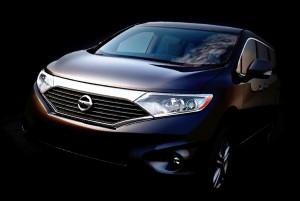Nissan has released the first image of the next generation Quest minivan and is attempting to change the image, not for the first time, of a vehicle in a class that exists because of utility.
The Quest in one of its previous versions attempted to use radical styling to set itself apart from the quintessential mom-mobiles, which offered unsurpassed levels of utility that minivans provide, going all the way back to the original and still formidable Chrysler minivans.
Nissan says that along with “top levels of quality and reliability, the all-new design is a fusion of sophistication, security and thoughtful utility for both families and empty-nesters alike.” Sound familiar?
The new Quest, which will be available in early 2011. The last major redesign was 2007, so this is a mid-cycle freshening.


Ken: The original Quest was not radical, merely a higher styled minivan, shared with the Mercury Villager (into’d in 1992). The radical one came later, and failed the “utility” test. The new one looks very good (glamour shot, I take it) but why would they want to get into the minivan classification? By the way, the original Villager-Quest series vehicles have weathered quite well, I’ve noticed. Thanks
You are right of course, Lee, and worse, I was around and covered it. The radical one came about a decade later. Ergo my original copy below
“The original Quest, of course, attempted to use radical styling to set itself apart from the quintessential mom-mobiles that minivans represent going all the way back to the original and still formidable Chrysler minivans.”
has now been changed, thanks to you, consider this an editing credit.
Not only that, but Ford and Nissan had a ten-year agreement in which Ford built the Mercury Villager/Nissan Quest minivan at an Ohio plant which otherwise would have been closed. Both sold relatively well, the Villager in traditional Mercury markets with a few conquests and Quest in the import markets through Nissan dealers whose customers would not have shopped a domestic dealer anyway.
When the ten years ended, each company shortsightedly went its own way. Ford badged a Windstar as a Monterrey, thereby losing any connection to the tens of thousands of Villager fans, while Nissan invested heavily in the referenced radical styling (and a new U.S. plant) which did not sell very well either. Ford then eliminated both the Windstar and the Monterrey, ending its participation in the minivan market which had become overcrowded anyway–just about the time crossovers rose to gnaw away at the the Mom market. Cloudy Crystal Ball Awards to both Ford and Nissan.
By the way, Villager was traditional Mercury nomenclature for station wagon models going back to the halcyon days of the Fifties and Sixties. I owned a ’66 Comet Villager station wagon with faux woodgrain appliique on sides and tailgate, subsequently acquired by auto editor Dave Smith.